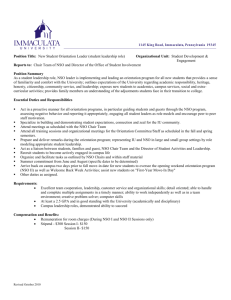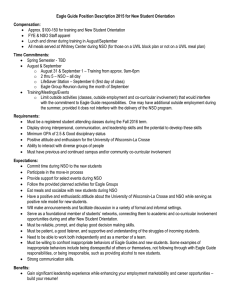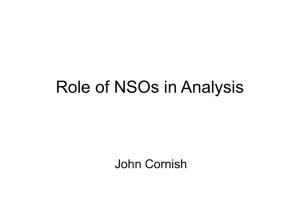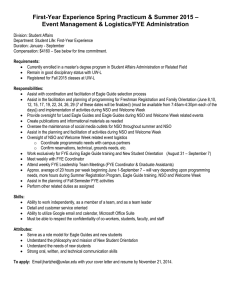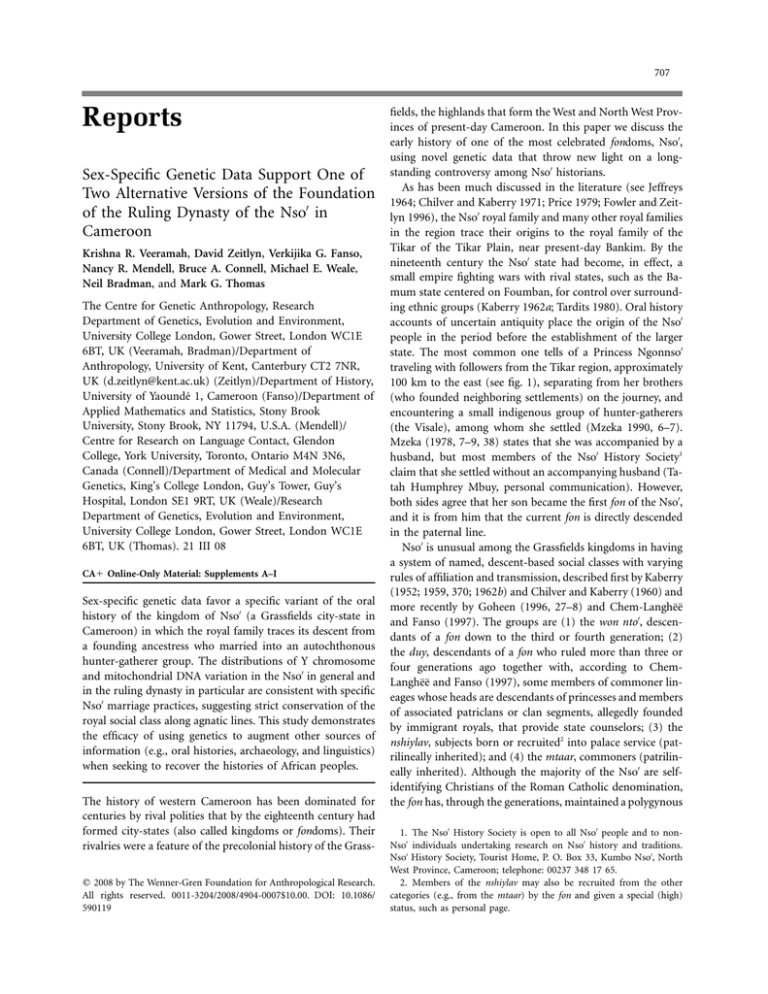
707
Reports
Sex-Specific Genetic Data Support One of
Two Alternative Versions of the Foundation
of the Ruling Dynasty of the Nso in
Cameroon
Krishna R. Veeramah, David Zeitlyn, Verkijika G. Fanso,
Nancy R. Mendell, Bruce A. Connell, Michael E. Weale,
Neil Bradman, and Mark G. Thomas
The Centre for Genetic Anthropology, Research
Department of Genetics, Evolution and Environment,
University College London, Gower Street, London WC1E
6BT, UK (Veeramah, Bradman)/Department of
Anthropology, University of Kent, Canterbury CT2 7NR,
UK (d.zeitlyn@kent.ac.uk) (Zeitlyn)/Department of History,
University of Yaoundé 1, Cameroon (Fanso)/Department of
Applied Mathematics and Statistics, Stony Brook
University, Stony Brook, NY 11794, U.S.A. (Mendell)/
Centre for Research on Language Contact, Glendon
College, York University, Toronto, Ontario M4N 3N6,
Canada (Connell)/Department of Medical and Molecular
Genetics, King’s College London, Guy’s Tower, Guy’s
Hospital, London SE1 9RT, UK (Weale)/Research
Department of Genetics, Evolution and Environment,
University College London, Gower Street, London WC1E
6BT, UK (Thomas). 21 III 08
CA⫹ Online-Only Material: Supplements A–I
Sex-specific genetic data favor a specific variant of the oral
history of the kingdom of Nso (a Grassfields city-state in
Cameroon) in which the royal family traces its descent from
a founding ancestress who married into an autochthonous
hunter-gatherer group. The distributions of Y chromosome
and mitochondrial DNA variation in the Nso in general and
in the ruling dynasty in particular are consistent with specific
Nso marriage practices, suggesting strict conservation of the
royal social class along agnatic lines. This study demonstrates
the efficacy of using genetics to augment other sources of
information (e.g., oral histories, archaeology, and linguistics)
when seeking to recover the histories of African peoples.
The history of western Cameroon has been dominated for
centuries by rival polities that by the eighteenth century had
formed city-states (also called kingdoms or fondoms). Their
rivalries were a feature of the precolonial history of the Grass䉷 2008 by The Wenner-Gren Foundation for Anthropological Research.
All rights reserved. 0011-3204/2008/4904-0007$10.00. DOI: 10.1086/
590119
fields, the highlands that form the West and North West Provinces of present-day Cameroon. In this paper we discuss the
early history of one of the most celebrated fondoms, Nso,
using novel genetic data that throw new light on a longstanding controversy among Nso historians.
As has been much discussed in the literature (see Jeffreys
1964; Chilver and Kaberry 1971; Price 1979; Fowler and Zeitlyn 1996), the Nso royal family and many other royal families
in the region trace their origins to the royal family of the
Tikar of the Tikar Plain, near present-day Bankim. By the
nineteenth century the Nso state had become, in effect, a
small empire fighting wars with rival states, such as the Bamum state centered on Foumban, for control over surrounding ethnic groups (Kaberry 1962a; Tardits 1980). Oral history
accounts of uncertain antiquity place the origin of the Nso
people in the period before the establishment of the larger
state. The most common one tells of a Princess Ngonnso
traveling with followers from the Tikar region, approximately
100 km to the east (see fig. 1), separating from her brothers
(who founded neighboring settlements) on the journey, and
encountering a small indigenous group of hunter-gatherers
(the Visale), among whom she settled (Mzeka 1990, 6–7).
Mzeka (1978, 7–9, 38) states that she was accompanied by a
husband, but most members of the Nso History Society1
claim that she settled without an accompanying husband (Tatah Humphrey Mbuy, personal communication). However,
both sides agree that her son became the first fon of the Nso,
and it is from him that the current fon is directly descended
in the paternal line.
Nso is unusual among the Grassfields kingdoms in having
a system of named, descent-based social classes with varying
rules of affiliation and transmission, described first by Kaberry
(1952; 1959, 370; 1962b) and Chilver and Kaberry (1960) and
more recently by Goheen (1996, 27–8) and Chem-Langhëë
and Fanso (1997). The groups are (1) the won nto , descendants of a fon down to the third or fourth generation; (2)
the duy, descendants of a fon who ruled more than three or
four generations ago together with, according to ChemLanghëë and Fanso (1997), some members of commoner lineages whose heads are descendants of princesses and members
of associated patriclans or clan segments, allegedly founded
by immigrant royals, that provide state counselors; (3) the
nshiylav, subjects born or recruited2 into palace service (patrilineally inherited); and (4) the mtaar, commoners (patrilineally inherited). Although the majority of the Nso are selfidentifying Christians of the Roman Catholic denomination,
the fon has, through the generations, maintained a polygynous
1. The Nso History Society is open to all Nso people and to nonNso individuals undertaking research on Nso history and traditions.
Nso History Society, Tourist Home, P. O. Box 33, Kumbo Nso, North
West Province, Cameroon; telephone: 00237 348 17 65.
2. Members of the nshiylav may also be recruited from the other
categories (e.g., from the mtaar) by the fon and given a special (high)
status, such as personal page.
708
Current Anthropology Volume 49, Number 4, August 2008
Figure 1. Towns in Cameroon where samples were collected.
household, which in 2005 numbered over 70 women.3 Access
to the fon’s wives has traditionally been strictly controlled,
with illicit unions subject to capital punishment (Chilver and
Kaberry 1968, 98–99). While paternal descent from a fon is
a necessary precondition for enthronement, the new fon’s
mother must, by the same tradition, be a mtaar (Mzeka 1978,
7–9, 38).
The membership rules, as commonly stated in abbreviated
form, do not cover all possible cases, particularly where the
change in status from won nto to duy is concerned. Because
this has implications for the distribution of sex-specific genetic markers in the wider population, we have undertaken
some further research to clarify the situation. The problem
is that Chem-Langhëë and Fanso’s (1997) definition of the
rule differs from Kaberry’s (1959). In the former, individuals
are won nto if they are “descendants of any fon of Nso to
the fourth generation through agnatic lines [strictly patrilineal
descent] and [read “or”] to the third generation through uterine connections [cognatic or strictly matrilineal descent]”
(Chem-Langhëë and Fanso 1997, 315). We call this royal social
status rule A. Individuals descended from one or more won
nto are duy if they are either descendants of a fon more than
four generations ago along agnatic lines or descendants of a
3. This information came from the late Emmanuel Nkem Mbinglo, a
paternal-line brother of the fon.
fon more than three generations ago through uterine connections (and in both cases not a descendant of a more recent
fon). Kaberry (1959, 370) simply says, “Descendants of a Fon
down to the third or fourth generation are described as
wonto.” There is consequently uncertainty about the status of
members of the fourth generation from a fon. To explore this,
a fictional family tree, designed to fit on one side of a sheet
of paper, was used as the basis for interviews with some
knowledgeable Nso (five males) in April 2007. Informants
varied as to whether the son of either a second- or a thirdgeneration female descendant of a fon is a won nto or a duy;
there really is uncertainty when there are female links in any
particular descent line. In practice, as part of Nso politics,
this can be exploited tactically. The Kaberry formulation of
the rule can be clarified in a variety of ways; for example, “a
person is a won nto (down to the fourth generation [if a
man] or third generation [if a woman]) if he or she is both
a child of a won nto and a descendant of a fon.” We call this
royal social status rule B. Our interviews ruled out the possibility that won nto status is inherited solely along paternal
lines. There are few circumstances in which an individual has
to declare class membership, and our informants agreed that
it might be possible for someone to be accepted as a won nto
in some circumstances but as a duy in others. At the boundary,
however, the question of membership does not appear to be
709
controversial. The discrepancy between rules A and B sets
limits for population genetic modeling and historical reconstruction.
Expectations of Sex-Specific Genetic Variation
Analysis of sex-specific genetic systems (the non-recombining
portion of the paternally inherited Y chromosome [NRY] and
the maternally inherited mitochondrial DNA [mtDNA]) has
proved useful in elucidating the history of diverse ethnic
groups when well-defined alternative scenarios can be identified (see, e.g., Thomas et al. 2000; Tambets et al. 2004).
Genetic data would be consistent with one of the two variants
of the oral history regarding the father of the first fon of
Nso—that Princess Ngonnso was already married to a man
of Tikar origin when she encountered the Visale or that she
took a Visale husband—if two conditions were satisfied: (a)
the distribution of NRY and mtDNA variation in the Nso
was consistent with expectations arising from the group’s declared social practices and (b) the NRY profile in the Visale
was distinct from that of migrants from the Tikar Plain.
We first examine whether it is possible to conclude that
either rule A or rule B has been followed. Assuming that (a)
the Y chromosome of the fon can be distinguished from those
of nonpatrilineal descendants of a fon, (b) numbers of males
and females in each generation are approximately equal, (c)
won nto females do not marry patrilineal descendants of a
fon, and (d) rule A has been followed, we would expect
33.4%–46.7% of won nto males that we sample to have the
same NRY type, while this type would be expected to asymptotically approach a frequency of 12.5% in won nto –descended duy, depending on the number of generations since
the original fon (“Royal Social Status Rule A” in CA⫹ online
supplement A). However, if rule B has been followed, we
would expect that only 1.0%–24.1% of sampled won ntov
males would have the same NRY type. We would expect this
type at a frequency of 12.5% in the won nto –descended duy,
irrespective of the number of generations of descent from a
fon (“Royal Social Status Rule B” in supplement A). These
expectations make it possible to establish whether rule A, rule
B, or neither has been followed.
An overall pattern of a shared NRY type in the won nto and duy should be most evident with respect to a battery of
rapidly evolving microsatellites on a unique event polymorphism (UEP)–defined haplogroup background and could
demonstrate that male-line continuity of fons has been maintained for at least the past four generations. The NRY of the
won nto would be expected to be significantly less diverse
than those of the other social classes. If the rules governing
selection of a fon have been strictly adhered to and there has
been no false paternity in the line of fons since the foundation
of the Nso, then this homogeneous NRY type will be that of
the first fon of Nso and his father. In addition, given (a) the
requirement that the mother of a fon be a commoner, (b)
that women move more freely among social categories in the
patrilineal Nso society, and (c) that extreme polygyny is practiced by fons, it would be expected that distributions of
mtDNA types would be similar in all four social classes.
If the above expectations were met, then we would be able
to use current knowledge of NRY variation in sub-Saharan
Africa to explore the oral history of the Nso. Underhill et al.
(2001) suggested that previously common NRY lineages may
have been replaced throughout sub-Saharan Africa by a lineage associated with the expansion of the Bantu-speaking peoples (EBSP).4 Scozzari et al. (1999) and Underhill et al. (2001)
have identified E3a as the modal NRY of the EBSP, using the
nomenclature of the Y Chromosome Consortium (2002; see
fig. B1 in CA⫹ online supplement B for the genealogical
relationships of the NRY UEP markers used to define haplogroups in this study). We would expect the putative replaced
NRY lineages to be observed at low frequencies and with a
patchy distribution across sub-Saharan Africa. These NRY
types would be remnants of indigenous populations that were
overwhelmed by populations carrying the E3a NRY type and
have been isolated from each other for a significant time
period. This would be reflected by high genetic distances at
the microsatellite haplotype level among geographically separated groups possessing the same single nucleotide polymorphism (SNP)–defined low-frequency NRY lineages (Underhill et al. 2001). However, these replaced NRY lineages
may be found at high local frequencies in existing populations
that predate the EBSP.
It would therefore be reasonable to assume that the huntergatherer Visale may have possessed one of these putative replaced NRY lineages at a frequency higher than that for the
Tikar (who speak a Bantoid language and so are connected
to the EBSP). A finding that the signature NRY type in the
won nto is one of the pre-EBSP lineages and is also not found
in neighboring Tikar populations (as well as other nearby
ethnic groups that may have experienced contact with Tikar)
would favor the scenario in which the immigrant princess
married an indigenous Visale. Conversely, the presence of a
homogeneous E3a lineage would favor Tikar paternity, or
patrilineal descent from some other Bantu/Bantoid group, of
the first Nso fon.
Analysis of the Genetic Structure of the Nso People
To examine the above hypotheses, we collected DNA samples
from males from each of the four Nso social classes (in a
fashion blinded to social class; “Sample Collection Procedure”
in supplement B), typed them for 11 UEPs (SNPs and indels)
and six microsatellites on the NRY (Thomas, Bradman, and
Flinn 1999), and sequenced hypervariable segment 1 (HVS4. We note the considerable simplification implicit in this statement.
Gene flow is not necessarily associated with language dispersion, and
NRY lineages are not necessarily associated exclusively with specific demographic events, but for our purposes there are enough hard data to
suggest a close correlation. Some of the complexity has been discussed
by Vansina (1995), MacEachern (2000), and Zeitlyn and Connell (2003).
710
Current Anthropology Volume 49, Number 4, August 2008
1) of their mtDNA (Thomas et al. 2002). Individual NRYs
were then assigned to haplogroups based on the UEPs according to the nomenclature of the Y Chromosome Consortium (2002) and further defined by their six-microsatellite
haplotypes (Kayser et al. 1997). The mtDNA types were defined by their variable-site-only (VSO) haplotypes (“mtDNA
Typing” in supplement B for a full explanation).
The most common NRY haplogroup in the won nto was
∗
Y (xBR,A3b2), with a frequency of 55.6% (n p 18; table 1).
This haplogroup was also found at a frequency of 17.6% in
the duy. Furthermore, all Y∗(xBR,A3b2) chromosomes had
the same microsatellite haplotype (14-12-20-11-14-14; CA⫹
online supplement C for all relevant NRY data). For convenience only we refer to Y∗(xBR,A3b2) and the associated microsatellite haplotype as the won nto modal haplotype
(WMH); it had ten representatives, while the next most frequent haplotype in the won nto had only two. The modal
NRY haplogroup in the non–won nto social classes was E3a,
with a diverse range of NRY types at the microsatellite haplotype level (h p 0.94 Ⳳ 0.01). Y∗(xBR,A3b2) NRYs were
found in the nonroyal social classes, but these included microsatellite haplotypes that were one to three mutation steps
different from the WMH, suggesting that they had originated
in the won nto or paternal ancestors of a founder of the won
nto and had diverged from the WMH. This accords with Nso
rules of class inheritance. At the UEP haplogroup level,
Fisher’s pairwise exact tests showed the won nto to be significantly different from all non–won nto social classes (P !
0.01), which in turn showed no significant differences from
each other (P 1 0.877). Genetic distances at the UEP ⫹ microsatellite haplotype level between the won nto and the other
three social classes were also all statistically significant (P !
0.01), with the greatest distance between the won nto and the
mtaar (FST p 0.101).
Expectations inferred from declared Nso social practices
are confirmed by the frequency and extreme homogeneity of
the WMH in the won nto and by the fact that a high-status
man generally considered to be a paternal descendant of a
recent fon possessed the WMH. A Pearson’s x2 goodness-offit test for continuity was performed to test the deviation of
the observed WMH frequency in the won nto from our expectations under both rule A and rule B. That rule A had
been followed could not be rejected at the 1% level (and could
be rejected only barely at the 5% level; x2 test against the
upper limit of expected frequency, 46.7%: P p 0.45, X 2 p
0.567, df p 1; against the lower limit, 33.4%: P p 0.046,
X 2 p 3.97, df p 1), in contrast to rule B, for which noncompliance is statistically significant (x2 test against the upper
limit of expected frequency, 24.1%: P p 0.001, X 2 p 9.73,
df p 1; against the lower limit, 1.0%: P ! 0.0001, X 2 p
541.15, df p 1). While these tests are dependent on twin assumptions of random sampling and equal reproductive success of non-fon won nto males, the size of the difference in
P values is strongly indicative of a real effect. This support
for rule A is notable: given that the WMH appears in non–won
nto males at a low frequency and that fon NRY types could
therefore enter the won nto through non–won nto males, our
expectation may have been an underestimate. Our data support male-line continuity of Nso fons up to at least the fourth
generation, and the WMH can thus be considered a likely
candidate for the NRY type passed down from the first fon
of Nso. There was insufficient statistical support to reject the
hypothesis that the frequency of Y∗(xBR,A3b2) in the duy is
in accordance with expectations based on declared social practices (x2 test against the expected frequency of 12.5%: P p
0.26, X 2 p 1.23, df p 1). There was no statistically significant
difference in the frequency of mtDNA types (CA⫹ online
supplement D) in combined or pairwise comparisons among
the four Nso classes (global exact test: P p 0.82 Ⳳ 0.05;
Fisher’s pairwise exact test: P 1 0.25). Therefore, the pattern
of both NRY and mtDNA variation in the Nso was in concordance with expectations based on rule A.
Association of the Y∗(xBR,A3b2) Lineage with the
Indigenous Hunter-Gatherer Visale
To examine the merits of the two versions of the oral history,
we were required to investigate the likely origins of
Y∗(xBR,A3b2). For the reasons set out in CA⫹ online supplement E, Y∗(xBR,A3b2) is a likely candidate to be one of
the NRY lineages replaced by the EBSP, as proposed by Underhill et al. (2001).
To establish that the WMH is not common in other groups
inhabiting the Grassfields or the land to the east, including
the Tikar Plain, we analyzed the NRYs of males from ten
neighboring ethnic groups (n p 780; table 2). Only one self-
Table 1. Distribution of NRY Haplogroups in the Four Nso Social Classes
NRY Haplogroup
P∗(xR1a)
BR∗(xDE,JR)
E∗(xE3a)
Y∗(xBR,A3b2)
E3a
Won nto (n p 18)
0
2
0
10
6
(0.000)
(0.111)
(0.000)
(0.556)
(0.333)
Duy (n p 51)
1
0
2
9
39
(0.020)
(0.000)
(0.039)
(0.176)
(0.765)
Mtaar (n p 21)
0
0
0
3
18
(0.000)
(0.000)
(0.000)
(0.143)
(0.857)
Nshiylav (n p 42)
0
1
1
8
32
(0.000)
(0.024)
(0.024)
(0.190)
(0.762)
Total (n p 132)
1
3
3
30
95
(0.008)
(0.023)
(0.023)
(0.227)
(0.720)
Note: Haplogroups are defined at the unique event polymorphism level. Number of NRYs characterized, with relative frequencies in parentheses.
Haplogroup nomenclature is that proposed by the Y Chromosome Consortium (2002).
711
declared non-Nso had a Y∗(xBR,A3b2) chromosome, and this
individual was born in Kumbo, the Nso capital.
A principal coordinates analysis plot (fig. 2) based on a
pairwise FST distance matrix calculated using NRY haplogroup
frequencies (see CA⫹ online supplement F for genetic distances and associated P values) clearly distanced the won nto
from both the other Nso social classes and other ethnic
groups, demonstrating that high frequencies of Y∗(xBR,A3b2)
are not typical of Grassfields and Tikar Plain NRY profiles.
Accordingly, because Y∗(xBR,A3b2) is typical of a huntergatherer population and the WMH is the most likely candidate to be the NRY type of the father of the first Nso fon,
the NRY data favor the oral tradition that the princess married
an indigenous Visale, from whom all subsequent fons descend.
Dating of the Y∗(xBR,A3b2) Lineage in the Nso
Given the close match between the distribution of NRY types
and one of the two main versions of the foundation story of
the ruling dynasty and given the potentially large number of
offspring likely to be descended from the founder of the line,
we estimated the time to the most recent common ancestor
(TMRCA) of the randomly collected Y∗(xBR,A3b2) NRYs observed in different social classes to investigate specific aspects
of Nso history. Because microsatellite mutation rates are variable among loci and alleles, confidence intervals (CIs) of this
time can be wide. Calculating a time to a very recent common
ancestor increases the level of uncertainty, and consequently
such calculations should be treated with caution. Oral history
suggests a time since the first fon of 250–700 years (Mzeka
1990).
Given the rules of social class inheritance and our previous
assertion that the first fon of Nso carried the WMH, it was
reasonable to postulate that all sampled duy with a
Y∗(xBR,A3b2) chromosome were male-line descendants of the
first fon. Consequently, to compare an estimate of the TMRCA
for all duy with a Y∗(xBR,A3b2) chromosome with the period
suggested by oral history, we applied the method of Behar et
al. (2003), using both a simple stepwise mutation model
(SSM) and a linear length-dependent stepwise mutation
model (L-SSM) as well as a variety of demographic models
to compute associated CIs (CA⫹ online supplement G for a
full explanation). Because all analyzed individuals had the
same microsatellite haplotype (the WMH), the actual point
estimate of the TMRCA was noninformative, but the upper
limit of the 95% one-tailed CI under realistic demographic
models was 1,035 years (assuming an intergeneration time of
20 years) or 1,112 years if microsatellite DYS388 was not used.
Therefore, our data are consistent with the oral history that
suggests that the founding of the Nso royal family occurred
within the past 1,000 years. Even under a more conservative
demographic model of constant population size, which is
known not to be the case for the general population in recent
centuries and is unlikely for a paternally inherited genetic
system possessed by an agnatically defined elite social group
practicing male polygamy, the upper limit was 1,497 years
(1,771 years without DYS388). This analysis was repeated with
the addition of using the Y∗(xBR,A3b2) NRYs found in the
won nto , who also all descend from the first fon. The results
are not reported here (although they can be found in ”YTIME
Results” in supplement G) because the won nto may enjoy a
reproductive advantage due to their elevated social position
(as least so far as a reigning fon is concerned), which is likely
to inflate the contribution made by their recent shared ancestry to the TMRCA calculation and thus adversely affect
the CIs for the TMRCA estimates on these samples (in this
case by reducing them).
Dating of the Y∗(xBR,A3b2) NRYs in the nshiylav and the
mtaar gave a TMRCA point estimate of 1,299 years (1,173
years without DYS388) under the SSM and 1,672 years (1,351
years without DYS388) under the L-SSM (combined twotailed 95% CI for both estimates is 176–7,119 years
[116–6,293 years without DYS388]). The upper limit of the
CI for the nshiylav and mtaar TMRCA estimate is much
higher than that for the duy. However, because the two CIs
overlap we could not, from this analysis alone, distinguish
between the depths of the two genealogies.
Given that the ancestral haplotype predicted for (a) the duy
Y∗(xBR,A3b2) NRYs is identical to that for (b) the nshiylav
and mtaar Y∗(xBR,A3b2) NRYs (the WMH), if the genealogies
of groups a and b were of the same depth, then it is likely
that they would have the same MRCA at the root of a common genealogy. The expectation would therefore be that the
average square distances (ASDs) of the group a and group b
Y∗(xBR,A3b2) NRYs would be similar. If, however, group b
had an older genealogy than group a, then the expectation
would be that the ASD of the former would be greater than
that of the latter. As explained in CA⫹ online supplement H,
it is reasonable to reject the hypothesis that the two groups
have the same MRCA and therefore conclude that the nshiylav
and the mtaar have a genealogy significantly older than that
of the duy.
This finding suggests that the Y∗(xBR,A3b2) NRYs in the
nshiylav and the mtaar descend not only from individuals of
the royal social class but also from Visale individuals who
were not made part of the royal family when the princess
arrived, because the hunter-gatherer Visale would be expected
to have a much older TMRCA than the duy. This is consistent
with the belief that the indigenous Visale accepted the rule
of the princess and her heir and became a mtaar lineage (there
are believed to be approximately 20 existing mtaar lineages
[Chilver and Kaberry 1968, 98–99]), on the condition that
all future fons have a mother of the mtaar social class (Mzeka
1978, 7–9, 38).
The Possible Evolution of a Relaxed Patrilineal
System of Descent for the Won Nto Although we were unable to reject rule A, the observed frequency of the WMH at 55.6% was somewhat above our ex-
(0.000)
(0.000)
(0.000)
(0.000)
(0.000)
(1.000)
0
0
0
0
0
30
(0.000)
(0.000)
(0.000)
(0.000)
(0.000)
(1.000)
0
0
0
0
0
20
(0.000)
(0.000)
(0.000)
(0.000)
(0.000)
(1.000)
0
10
6
0
0
136
(0.000)
(0.066)
(0.039)
(0.000)
(0.000)
(0.895)
1
1
1
0
0
72
(0.013)
(0.013)
(0.013)
(0.000)
(0.000)
(0.960)
3
2
7
8
0
134
(0.019)
(0.013)
(0.045)
(0.052)
(0.000)
(0.870)
1
8
2
0
0
70
(0.012)
(0.099)
(0.025)
(0.000)
(0.000)
(0.864)
0
2
0
0
1
53
(0.000)
(0.036)
(0.000)
(0.000)
(0.018)
(0.946)
0
1
1
0
0
45
(0.000)
(0.021)
(0.021)
(0.000)
(0.000)
(0.957)
5
29
17
8
1
720
(0.006)
(0.037)
(0.022)
(0.010)
(0.001)
(0.923)
Note: Number of NRYs characterized, with relative frequencies in parentheses. Haplogroup nomenclature is that proposed by the Y Chromosome Consortium (2002). A p Aghem-speakers
in Wum. B p Bafut-speakers in Bafut who did not declare a Tikar ethnic identity. BT p Bafut-speakers in Bafut who declared a Tikar ethnic identity. Bl p Bamileke-speakers located
throughout the western Grassfields and Tikar plain; it is claimed that they were displaced from their homeland of Mbam on the Tikar plain. Bm p Bamun-speakers in Foumban. K p
Kwandja-speakers in towns in the northeastern region of the Tikar plain, such as Nyamboya. M p Mambila-speakers in towns near the Nigerian border on the Tikar plain, such as Atta,
Somie, and Songkolong, and in Mayo Darle. T p Tikar-speakers in towns on the Tikar plain, such as Magba, Sabongari, and Bankim. W p Wimbum-speakers in Nkambe. Y p Yambaspeakers in towns throughout the Tikar plain, such as Sabongari, Magba, Bankim, Somie, Songkolong, and Atta, and in Mayo Darle.
0
0
0
0
0
66
0
5
0
0
0
94
P∗(xR1a)
BR∗(xDE,JR)
E∗(xE3a)
A3b2
Y∗(xBR,A3b2)
E3a
(0.000)
(0.051)
(0.000)
(0.000)
(0.000)
(0.949)
A (n p 99) B (n p 66) BT (n p 30) Bl (n p 20) Bm (n p 152) K (n p 75) M (n p 154) T (n p 81) W (n p 56) Y (n p 47) Total (n p 780)
NRY Haplogroup
Table 2. Distribution of NRY Haplogroups in the Peoples of the Western Grassfields and the Tikar Plain
713
Figure 2. Principal coordinates analysis plot of UEP-based population
pairwise FST values. The plot is constructed using pairwise genetic distances FST (Reynolds, Weir, and Cockerham 1983) between the four Nso
classes (labeled by name) and other populations of the western Grassfields
and Tikar Plain (labeled with abbreviations from table 2). PCO1 and
PCO2 explain 97.91% and 1.92% of the variation, respectively.
pected range. A higher than expected frequency is not a problem in our analysis because male-line continuity of fons has
been clearly demonstrated, permitting us to define a putative
NRY type for the first fon of Nso. One possible explanation
for this (CA⫹ online supplement I) is that the won nto may
have evolved or may be evolving into a more patrilineally
defined group.
Conclusion
It is frequently difficult to establish how, where, and when
events that are the subject of oral history occurred, even in
accounts in which categorical assertions are made. Nevertheless, such narratives can prove valuable sources of information. Confidence in conclusions reached from the analysis of
oral tradition is increased when they are supported by data
from other sources, for example, linguistics and archaeological
excavation. We have shown that the distribution of NRYs and
mtDNA is consistent with an oral history that describes fusion
of an indigenous hunter-gatherer group with later migrants
and paternal descent of the ruling dynasty from the indigenous inhabitants of the land over the period covered by that
history.
The frequency of the WMH in the won nto social class
accords very well with what one would predict from population genetic theory and our sampling strategy and illustrates
the power of genetic anthropology to confirm the genetic
consequences of social practices and labels. We have been able
to provide support to a description of the social system put
forward by one group of researchers as opposed to that of
another. We have also shown that, in the investigation of the
histories of groups living in sub-Saharan Africa, genetic analysis may prove a valuable tool in the armory of scholars
seeking to elucidate, on a fine scale, the prehistories of subSaharan African populations.
Acknowledgments
This work was supported by the Biotechnology and Biological
Sciences Research Council and the Melford Charitable Trust.
We would like to thank all DNA sample donors and Abigail
Jones, Richard Phillips, and Ali Barwani, who performed some
NRY typing, and Adam Powell, who performed the algebraic
simplification. The study was carried out in accordance with
Cameroon Research Permits 0188/MINREST/B00/D00/D10/
D12 and 317/MINREST/B00/D00/D10. Correspondence and
requests for materials should be addressed to David Zeitlyn.
References Cited
Behar, D. M., M. G. Thomas, K. Skorecki, M. F. Hammer, E.
Bulygina, D. Rosengarten, A. L. Jones, et al. 2003. Multiple
origins of Ashkenazi Levites: Y chromosome evidence for
both Near Eastern and European ancestries. American Journal of Human Genetics 73:768–79.
Chem-Langhëë, B., and V. G. Fanso. 1997. Social categories,
local politics and the uses of oral tradition in Nso. Paideuma 43:313–27.
Chilver, E. M., and P. M. Kaberry. 1960. From tribute to tax
in a Tikar chiefdom. Africa 30:1–19.
———. 1968. Traditional Bamenda: The pre-colonial history
and ethnography of the Bamenda Grassfields. Buea: Ministry
of Primary Education and Social Welfare and West Cameroon Antiquities Commission.
———. 1971. The Tikar problem: A non-problem. Journal
of African Languages 10:13–4.
714
Fowler, I., and D. Zeitlyn. 1996. Introduction: The Grassfields
and the Tikar. In African crossroads: Intersections between
history and ethnography in Cameroon, ed. I. Fowler and D.
Zeitlyn, 1–16. Oxford: Berghahn.
Goheen, M. 1996. Men own the fields, women own the crops:
Gender and power in the Cameroon Grassfields. Madison:
University of Wisconsin Press.
Jeffreys, M. D. W. 1964. Who are the Tikar? African Studies
23:141–53.
Kaberry, P. 1952. Women of the Grassfields. London: Her Majesty’s Stationery Office.
———. 1959. Traditional politics in Nsaw. Africa 29:366–83.
———. 1962a. The date of the Bamun-Banso war. Man 62:
140.
———. 1962b. Retainers and royal households in the Cameroon Grasslands. Cahiers d’Études Africaines 3:282–98.
Kayser, M., A. Caglià, D. Corach, N. Fretwell, C. Gehrig, G.
Graziosi, F. Heidorn, et al. 1997. Evaluation of Y-chromosomal STRs: A multicenter study. International Journal
of Legal Medicine 110:125–29.
MacEachern, Scott. 2000. Genes, tribes, and African history.
Current Anthropology 41:357–84.
Mzeka, P. N. 1978. The core culture of Nso . Agawam, Mass.:
Jerome Radin.
———. 1990. Four fons of Nso : Nineteenth and early twentieth
century kingship in the western Grassfields of Cameroon. Bamenda, Cameroon: Spider Publishing.
Price, David. 1979. Who are the Tikar now? Paideuma 25:
89–98.
Reynolds, John, B. S. Weir, and C. Clark Cockerham. 1983.
Estimation of the coancestry coefficient: Basis for a shortterm genetic distance. Genetics 105:767–79.
Scozzari, R., F. Cruciani, P. Santolamazza, P. Malaspina, A.
Torroni, D. Sellitto, B. Arredi, et al. 1999. Combined use
of biallelic and microsatellite Y-chromosome polymorphisms to infer affinities among African populations. American Journal of Human Genetics 65:829–46.
Current Anthropology Volume 49, Number 4, August 2008
Tambets, K., S. Rootsi, T. Kivisild, H. Help, P. Serk, E. L.
Loogvali, H. V. Tolk, et al. 2004. The western and eastern
roots of the Saami—the story of genetic “outliers” told by
mitochondrial DNA and Y chromosomes. American Journal of Human Genetics 74:661–82.
Tardits, C. 1980. Le royaume Bamoun. Paris: Libraire Armand
Colin.
Thomas, M. G., N. Bradman, and H. M. Flinn. 1999. High
throughput analysis of 10 microsatellite and 11 diallelic
polymorphisms on the human Y-chromosome. Human Genetics 105:577–81.
Thomas, M. G., T. Parfitt, D. A. Weiss, K. Skorecki, J. F.
Wilson, M. Le Roux, N. Bradman, and D. B. Goldstein.
2000. Y chromosomes traveling south: The Cohen modal
haplotype and the origins of the Lemba—the “black Jews
of southern Africa.” American Journal of Human Genetics
66:674–86.
Thomas, M. G., M. E. Weale, A. L. Jones, M. Richards, A.
Smith, N. Redhead, A. Torroni, et al. 2002. Founding mothers of Jewish communities: Geographically separated Jewish
groups were independently founded by very few female
ancestors. American Journal of Human Genetics 70:1411–20.
Underhill, P. A., G. Passarino, A. A. Lin, P. Shen, M. Mirazón
Lahr, R. A. Foley, P. J. Oefner, and L. L. Cavalli-Sforza.
2001. The phylogeography of Y chromosome binary haplotypes and the origins of modern human populations.
Annals of Human Genetics 65:43–62.
Vansina, J. 1995. New linguistic evidence and the Bantu expansion. Journal of African History 36:173–95.
Y Chromosome Consortium. 2002. A nomenclature system
for the tree of human Y-chromosomal binary haplogroups.
Genome Research 12:339–48.
Zeitlyn, David, and Bruce Connell. 2003. Ethnogenesis and
fractal history on the African frontier: Mambila-NjerepMandulu. Journal of African History 44:117–38.


